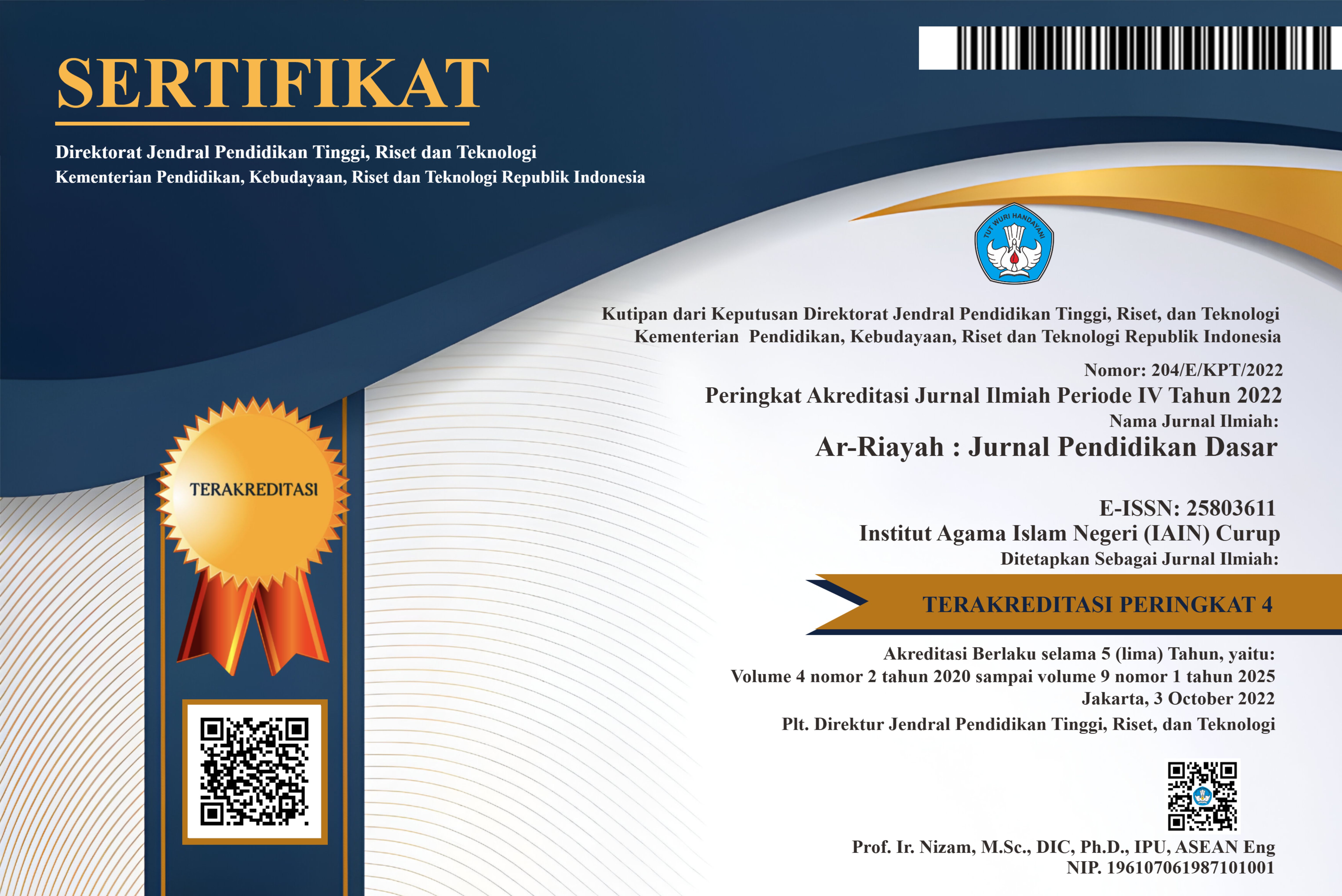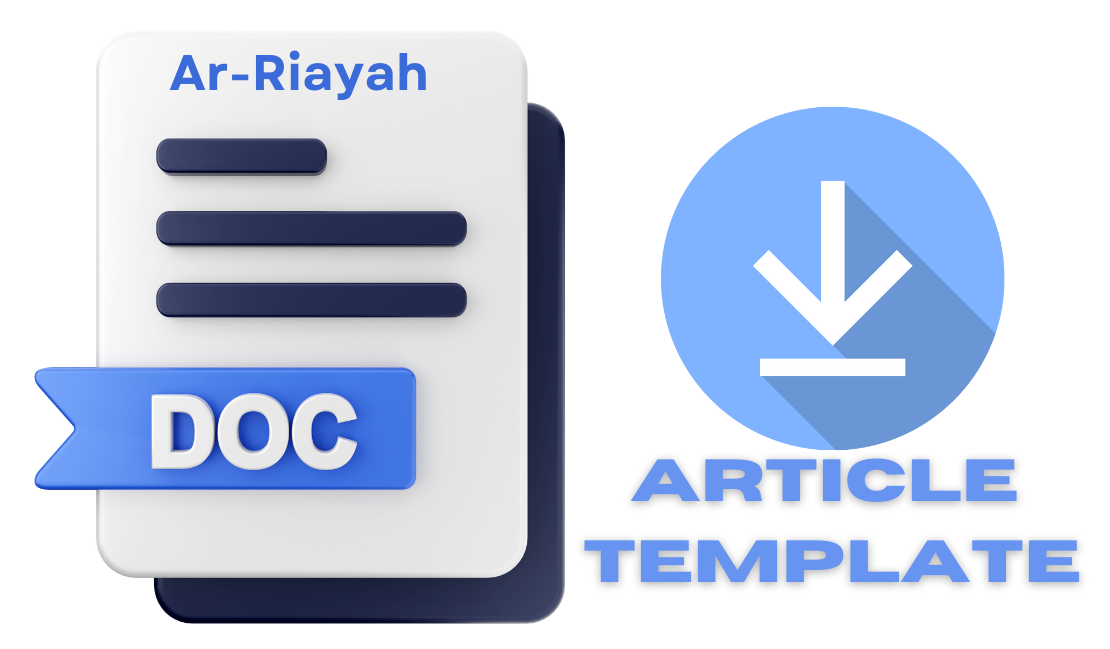Analisis Disposisi Matematis pada Pembelajaran Matematika di Sekolah Dasar
DOI:
https://doi.org/10.29240/jpd.v8i1.10021Keywords:
Mathematical Disposition, Mathematics Learning COREAbstract
The problems of this research are students' lack of attention to the teacher's explanation, lack of enthusiasm for lessons and their lack of curiosity in mathematics lessons. Then, the aims of this research are to know students’ mathematical disposition and the results of the mathematical disposition of students at grade 5 SDIT Khoiru Ummah after using the CORE (Connecting, Organizing, Reflecting, Extending) learning model. The type of the research was quantitative descriptive research. The population was 63 students with a sample of 30 students using purposive sampling. The data collection technique was in the form of observation and a questionnaire consisting of 20 questions referring to 5 indicators of mathematical disposition. The second data used had been validated by experts. From the research results of applying the CORE (Connecting, Organizing, Reflecting, and Extending) learning model to the mathematical disposition of grade 5 students at SDIT Khoiru Ummah, it was shown that teacher and students’ activities are very good. The results of the students' mathematical disposition obtained from the questionnaire were classified as high as many as 23 people, medium as many as 4 people and low as many as 3 people.
Downloads
References
Ahmad. NCTM Ibdikator Disposisi Matematis Siswa, 2014.
Akhtar, Hanif. Cara Membuat Kategorisasi Data Penelitian Dengan SPSS Semesta Psikometrika Diakses Pada Selasa, n.d.
Antoni, Siagian Pergaulan, and Surya Edy. “Pengembangan Perangkat Pembelajaran Melalui Model Siswa Sma.†Paradikma Jurnal Pendidikan Matematika 12, no. 2 (2019): 1–10.
Bernard, Martin. “Meningkatkan Kemampuan Komunikasi Dan Penalaran Serta Disposisi Matematik Siswa SMK Dengan Pendekatan Kontekstual Melalui Game Adobe Flash CS 4.0.†Jurnal Ilmiah Program Studi Matematika 4, no. 2 (2015): 202.
Beyers, J.E.R. “An Examination of the Relationship Between Prospective Teachers’ Dispositions and Achievement in a Mathematics Content Course for Elementary Education Majors.†Journal of SAGE Open. International Journal OfBusiness and Social Science 2, no. 16 (2012): 20–23.
Dina, Z. H, M Ikhsan, and H Hajidin. “The Improvement of Communication and Mathematical Disposition Abilities through Discovery Learning Model in Junior High School.†JRAMathEdu (Journal of Research and Advances in Mathematics Education 1, no. 1 (2019): 11–22.
Diningrum, Putri Risti, Ervin Azhar, and Ayu Faradillah. “Hubungan Disposisi Matematis Terhadap Kemampuan Komunikasi Matematis Siswa Kelas VII Di SMP Negeri 24 Jakarta.†Jurnal Pendidikan Matematika 1, no. 2 (2018): 355.
Eriyanto. Metodologi Polling: Memberdayakan Suara Rakyat. Bandung: Remaja Rosdakarya, 1999.
Fajri, Qiyamul. “Pengaruh Disposisi Matematis Terhadap Kemampuan Penalaran Matematis Siswa (Studi Pada Siswa Kelas VII SMP Negeri 1 Buay Madang Timur Semester Ganjil Tahun Pelajaran 2022/2023).†In Skripsi, 29. Lampung: UNILA, 2022.
Hidayah, Desi Nur. “Analisis Disposisi Matematis Siswa Dalam Pembelajaran Matematika Model Elicting Activities (MEA).†In Skripsi, 24–26. Lamongan, 2021.
Listiani, N. M. “Pengaruh Kreativitas Dan Motivasi Terhadap Hasil Belajar Mata Pelajaran Produktif Pemasaran Pada Siswa Kelas XI SMK Negeri 2 Tuban. , 2(2), 263.†Jurnal Ekonomi Pendidikan Dan Kewirausahaan 2, no. 2 (2017): 263.
Menengah, Salinan Lampiran Peraturan Menteri Pendidikan dan Kebudayaan Nomor 35 Tahun 2018 tentang Kurikulum 2013 Penidikan Dasar dan. “No Title,†n.d.
Nurfitriyanti, Maya. “Peningkatan Kemampuan Disposisi Matematika Melalui Pembelajaran Berbasis Aktivitas Siswa.†Jurnal SAP 2, no. 8 (2017): 87.
Oktaviani, R, H. Suyitno, and Mashuri. “Keefektivan Model Elicting Activities Berbantuan LKPD Terhadap Kemampuan Komunikasi Matematis Dan Disposisi Matematis Peserta Didik Kelas VIII.†UNNES Journal of Mathematics Educations 5, no. 3 (2016): 191.
Prastiyo, A W. Djohar, and Purnawan. “Development Of Youtube Integrated Google Classroom Based Learning Media For The Light-Weight Vehicle Engineering Vocational High School.†Jurnal Pendidikan Vokasi 8, no. 1 (2018): 53–56.
Ramli, Restu Wirdayanti. “Analisis Kemampuan Siswa Dalam Menyelesaikan Soal Matematika Tipe Higher Order Thinking Skill (HOTS) Pokok Bahasan Pola Bilangan Pada Kelas VIII A SMP Negri 1.†In Skripsi, 48. Sungguminasa: Universitas Muhammadiyah Makasar, 2020.
Salinan Lampiran Peraturan menteri Pendidikan dan Kebudayaan Nomor 21 Tahun 2016 tentang Standar Isi Pendidikan Dasar dan Menengah, 116. “No Title,†n.d.
Sormin, Masdelima Azizag, Mukhtar, and Edi Syahputra. “Peningkatan Kemampuan Komunikasi Dan Disposisi Matematis Siswa Melalui Pembelajaran Kooperatif Tipe Jigsaw Di SMP Muhammadiyah Kota Padangsidimpuan.†Jurnal Paradikma 10, no. 2 (2019): 177.
Sumarmo, Utari. Penilaian Pembelajaran Matematika. Bandung: PT Refika Aditama, 2019.
Sumirat. National Council of Teacher Mathemati, Indikator Disposisi Matematis, 2014.
Wardhani. Penelitian Tindakan Kelas. Jakarta: Universitas Terbuka, 2008.
Widyasari, Nurbaiti, Jarnawi Afgani Dahlan, and Stanley Dewanto. “Meningkatkan Kemampuan Disposisi Matematis Siswa SMP Melalui Pendekatan Metaphorical Thinking.†Jurnal Pendidikan Matematika Dan Matematika 2, no. 2 (2016): 29.
Downloads
Published
How to Cite
Issue
Section
Citation Check
License
Authors who publish with Ar-Riayah: Jurnal Pendidikan Dasar agree to the following terms:
Authors retain copyright and grant the journal right of first publication with the work simultaneously licensed under a Creative Commons Attribution-NonCommercial-ShareAlike 4.0 International License (CC BY-NC-SA 4.0) that allows others to share the work with an acknowledgment of the work's authorship and initial publication in this journal.
Authors are able to enter into separate, additional contractual arrangements for the non-exclusive distribution of the journal's published version of the work (e.g., post it to an institutional repository or publish it in a book), with an acknowledgment of its initial publication in this journal.
- Authors are permitted and encouraged to post their work online (e.g., in institutional repositories or on their website) prior to and during the submission process, as it can lead to productive exchanges, as well as earlier and greater citation of published work (See The Effect of Open Access).










